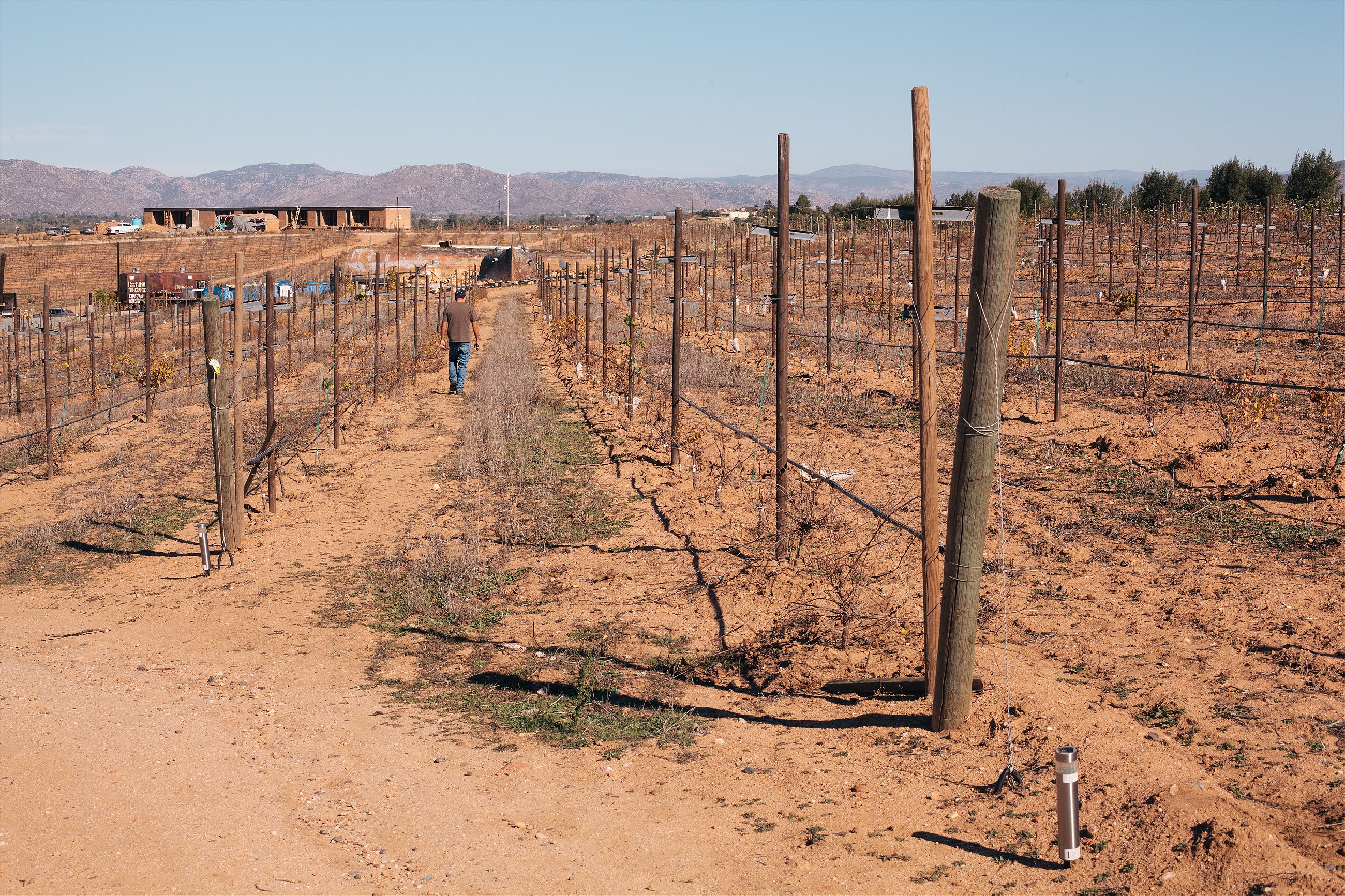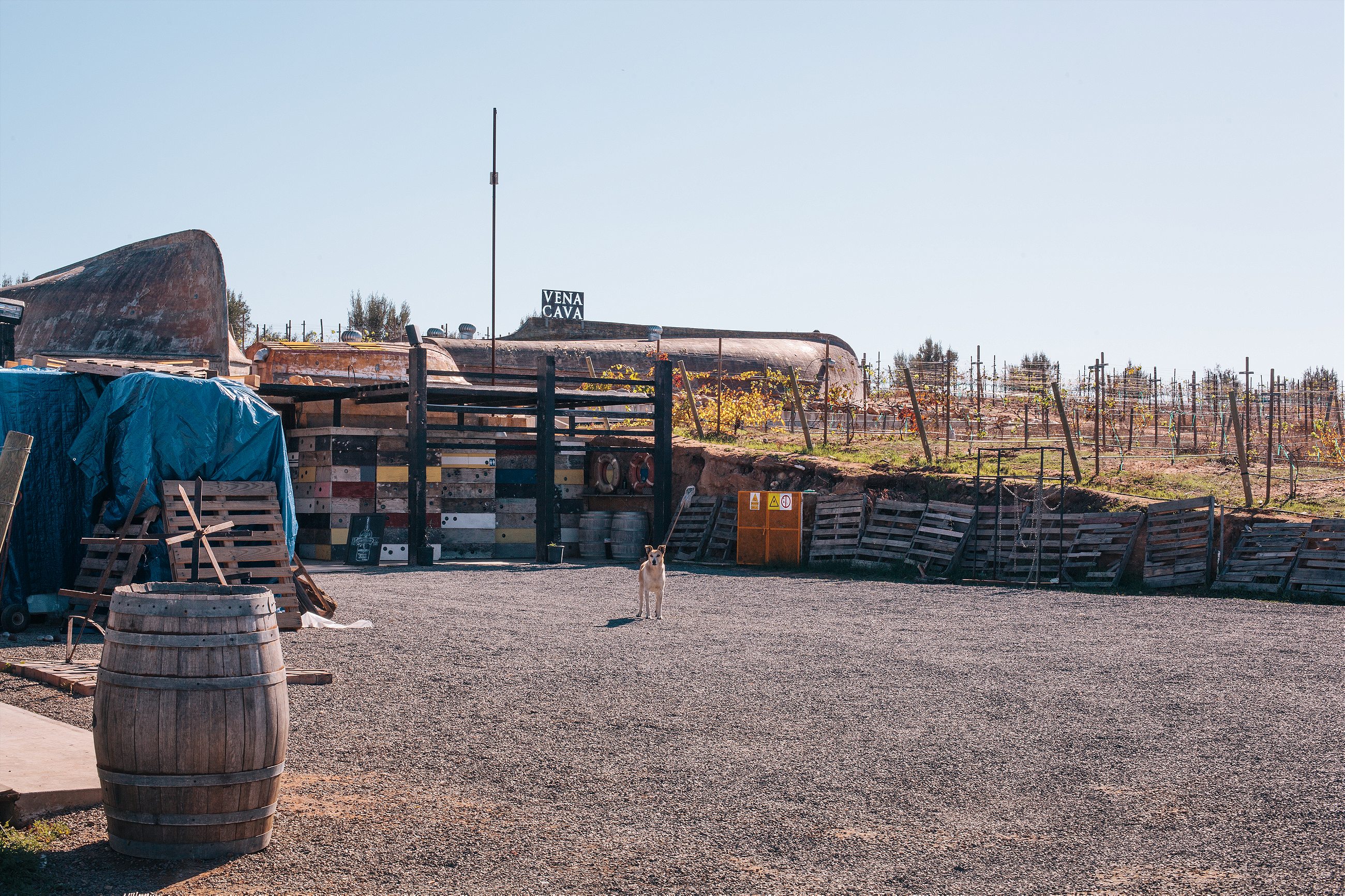A looming crisis in Mexico’s Valle de Guadalupe vineyards.
Valle de Guadalupe is Mexico’s wine country. The grapes grow in a vast valley here, before being turned into wine and bottled for tourists—both domestic and foreign—looking to experience another side of Mexico. Abalone is fished from local coves, grilled with a sprinkle of local olive oil and served on artisan-crafted ceramic plates.
People come here to sip little-known red wine blends and huddle up next to a roaring fire as the air cools and the sun slips behind the desert mountains. Then they return to their hotels, where they run the shower, blissfully unaware that every drop of water they use brings their hosts closer to disaster.
Valle de Guadalupe is a short drive from both Tijuana and San Diego. It’s a beautiful valley in the Mexican state of Baja California, flanked by desert mountains on three sides and the ocean on the fourth. It’s filled with rows of lush vines as far as the eye can see. The region has a drier version of the Mediterranean climate, and is where 70 percent of Mexico’s wine is made.
Just four years ago, there were about 50 wineries here. Now, there are over 150. Today, the Valle, as locals call it, produces around 1.5 million cases of wine a year. But now, the area is running out of water. Much of the state of Baja California is a desert, backed by the Pacific Ocean on the west side and the Sea of Cortez on the east.
The Valle is minutes from the port city of Ensenada. Rain has never been plentiful here, but for decades groundwater reserves seemed to be sufficient, and there are several coastal aquifers just south of the city. But the aquifers are contaminated with saltwater, and the rain has all but stopped, according to Dr. Rogelio Vazquez Gonzalez, a local geophysicist. “We’re going to have to learn how to deal with this, because the climate isn’t going to stop changing,” he says. “People may not believe it, but it’s true, and it’s happening even faster than we expected.”

“They make wine in Mexico?” is the first thing many people ask when they hear about the Valle. In fact, Mexico has been doing so since the 1500s, when Spanish missionaries first planted vines in the extreme northwest of the country, now known as Baja California. Then, in about 1699, Spanish colonists noticed their wine exports to Mexico had slowed to a trickle, so they ripped up the vines and banned wine production in the colony.
After Mexican independence, Bodegas Santo Tomas opened up shop, becoming the first actual Baja winery in 1888. In the early 1900s, an influx of Russians brought a little more planting, but this remained the extent of it until the 1980s, when commercial winemaking was stepped up. Since then, dozens of wineries have followed, although the region doesn’t yet have an official denominacion de origen, a protective classification for wine based on where its grapes are grown.
Now, everyone wants a piece of the action. Tour companies are springing up, and every season brings a new restaurant, hotel or winery. Bottles have made their way around Mexico and are now becoming increasingly prevalent on menus across the border in the U.S.
Like other winemaking regions around the world, the Valle de Guadalupe is a magnet for people with money. Day-trippers drive 90 minutes from the U.S., crossing the border and driving down the coast on Mexico’s Highway 1D. They arrive at a valley of tony open-air restaurants and quirky wineries.
You can’t put a million straws in the same glass and expect to keep drawing water
The wine, getting better every year, is an exciting change from a standard Napa Valley Cabernet Sauvignon. Varietals have bolder, more complex flavors than their counterparts in other regions, thanks to the climate and the rocky, porous soil here. Winemakers are particularly known for creating red blends you won’t find anywhere else in the world.
The Valle encompasses a large swath of farmland between two dusty villages, El Porvenir and Francisco Zarco. There are two tarred roads connecting each of the villages, with a web of dirt roads in between. Most of the local economy is devoted to agriculture and, increasingly, tourism. The villages are largely working and middle class and, in general, have benefitted from the buzz surrounding their region.
But the increasing demand for water has outstripped the Valle’s infrastructure. Geophysicist Vazquez explains that over time, rainfall has decreased and consumption has increased due to population growth and an increase in wine production. So a lot more water is being taken out of the water table than is being put back in. “It’s like a cup of water,” says Vazquez. “You can’t put a million straws in the same glass and expect to keep drawing water, but that’s what everyone’s doing.”

Eileen Gregory and her husband Phil moved to the Valle in 2002 after leaving the music business in Los Angeles. They now run the hotel and winery La Villa del Valle, as well as the popular Corazon de Tierra restaurant. Gregory is exasperated by the water situation. “Our new neighbor is building an eight-room hotel right next to us and built a perforated well that goes deeper than ours,” she says. “So, our water is just about gone because they drilled deeper than us. We now have to buy water, which is not sustainable at all. Especially because we buy locally from people who still have water, which is the same source we used to draw from.”
And that’s not the only problem. The quality of the water is getting worse as well. The Valle de Guadalupe was once an ocean bed and stores vast reserves of salt in its soil. As water is extracted, salt remains, increasing the salinity of whatever water is still in the ground. The result is that some wine from the area has a briny quality.
Champions of salty wine say it is just part of the terroir, while others dismiss this as an excuse for poor land management and winemaking. Many winemakers have built small desalination plants, and the Valle’s best wines generally don’t have any salty notes, though they do maintain a favorable minerality.
There are several possible fixes: better zoning to control growth, more desalination plants, and increased diversification to regions with more water. Vazquez, the geophysicist, thinks taking sand from creeks and arroyos will improve water absorption from rain and fog. He also thinks building a high-volume desalination plant along with a water treatment plant in Ensenada is the only way to run a water system in the uncertain climate.

Nearby Tijuana is home to a large fleet of maquiladoras: foreign-owned factories that produce goods to be shipped back to the U.S., China, Korea or Japan. Many have wondered aloud why water from the factories isn’t being recycled. Can the industrial runoff be made safe enough for agricultural use? Vazquez notes there’s an aqueduct running from Tijuana to Ensenada, which was built to flow from Ensenada but can be reversed.
A few years ago, the owner of the largest vineyard in the Valle, Don Luis Cetto, worked with government officials to build another aqueduct, paid for by the government. It would have transported grey water (relatively clean water used in industrial processes) from Tijuana to a newly minted, government-sponsored water treatment plant on Cetto’s land in the Valle, but he would control the water.
The plan was met with fierce opposition from several winemakers, who balked at the idea that one of their own would control water distribution and pricing. Several winemakers I spoke with said the project, which had always been hush-hush, went away without much fanfare about two years ago.

There are many reasons why a desalination plant or water treatment plant won’t get built, says geophysicist Vazquez. “We have a lot of problems in this country. One of the biggest is education on this particular subject—people don’t know or understand, so they can be misled to take a position that isn’t in their best interest,” he says. “Also, there is a lot of corruption.”
Gregory, the winery owner, told me about a scandal from a few years ago, when Ensenada’s former mayor, Enrique Pelayo Torres, banded together with a local businessman, Carlos Lagos, to build 30,000 low-income houses in the valley. This was despite the fact that there’s almost no infrastructure to support more residents. The motion passed quickly, with a lot of subterfuge and without public approval, but was abandoned when Pelayo left office later the next year.
Further complicating matters is the sour relationship between winemakers and the local ejido landowners. The ejido system was developed by the federal government to provide communal land for agricultural use. In 1992, a combination of low agricultural productivity and corruption inspired then President Carlos Salidas de Gortari to allow for privatization and sale of ejido land. The ejidos in the Valle were typically in favor of Pelayo’s low-income housing project, as they would have been able to sell their land at a premium.
And, of course, money is a problem, says Vazquez. If hotels in the Valle raised room rates by just a few dollars a night, a water tax of sorts, that would go a long way towards paying desalination and treatment costs, he notes.
Winemakers are taking matters into their own hands
Residents told me no actual plans to improve the situation are in the works. There’s a strong inertia, says Walter Raúl Zúñiga Castillo, a local government planning official. “The current climate of development, or lack thereof, originates from government, society, and academia being unable to come together to find a workable solution,” he says.
For now, winemakers are taking matters into their own hands. Some farmers have resorted to using polymer gels on the roots of their vines, which capture small amounts of moisture from the air. Others have banded together to form water-treatment consortiums, building small communal plants. Others are cutting grape clusters, which improves grape quality but cuts production. Dry farming, a technique that relies on rain and lets the roots grow deeper to find water, is becoming a thing of the past, so farmers are ditching sprinklers and switching to subsurface and drip systems. Many others are looking beyond Valle de Guadalupe, to larger and more fertile valleys like Ojos Negros, Valle Santo Tomas, and Valle San Vicente.
Whatever happens, it needs to be done quickly. Vazquez believes the Valle de Guadalupe needs three or four years of sustained winter rains to get the water table back to healthy and sustainable levels. He believes it will rain again, though he concedes it’s anyone’s guess as to how far off that might be. In the meantime, wine production could be reduced by more than half, Vazquez says.
“The plants won’t die, but will produce far less fruit,” he explains. “Hotels and restaurants can truck water in, but farmers can’t.” Winter brings the La Niña weather pattern, which historically means dry conditions. If that bears out and it doesn’t rain over the winter, the Valle will run out of water within two years, according to Vazquez. “I think there will be a collapse, and then people will scramble to fix it.”